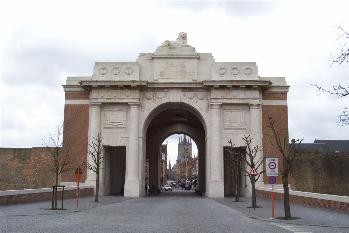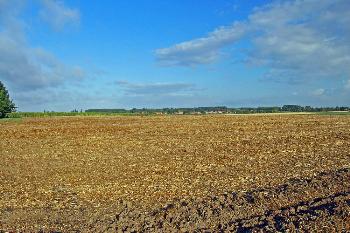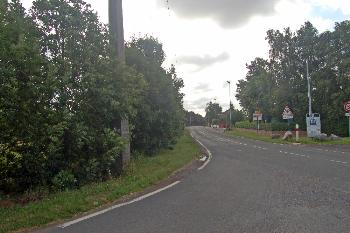The Sandy war memorial stands next to the recreation ground on Bedford Road. It contains 126 names of Sandy men killed in the First World War. The size of Sandy, including its hamlets was 3,377 in the 1911 census. Of these men 53 were killed serving with the Bedfordshire Regiment. Bedfordshire and Luton Archives and Records Service has the war diaries of each of the battalions of the regiment to see active service. The numbers of Sandy dead for the Regiment each year are as follows:
All four men from Sandy to die with the Bedfordshire Regiment in 1914 belonged to the 1st Battalion. By contrast, 1915 saw only one member of that Battalion lose his life, whereas five men died with the 2nd Battalion.
The first man to die was Percy John Boness. He had been born in Girtford, though by the time the Commonwealth War Graves Commission obtained his personal details his parents, Charles and Ellen were living in Tilbury [Essex]. Percy was just 21 when he was killed in action with the 2nd Battalion on 12th March 1915. The battalion were taking part in the Battle of Neuve-Chapelle, the first major British offensive of the war. It rather set the pattern for future offensives by being very successful on the first day (10th March) when meticulous planning gave the attackers an advantage but German counterattacks thereafter caused confusion and generals, lacking reliable communications, could not respond quickly enough to a fast moving situation. The battle lasted until 13th March and both sides lost around 11,000 men for no gains whatsoever.
The Germans made a determined counterattack on 12th March when a salient occupied by the Royal Scots Fusiliers to the east of the town was captured. An initial counterattack by the Bedfords was unsuccessful but that Captain Charles Calverley Foss and nine other ranks from a grenade section managed to retake it. For this Foss received the Victoria Cross and most of his group were also later decorated. In all fifteen other ranks were killed in the unsuccessful attack, sixty six wounded and five reported missing. Percy Boness may have been one of the latter. His body was never found and he is commemorated on the Le Touret Memorial to the Missing.
On 5th June Acting Corporal George William Franklin of the 1st Battalion was killed in action. He had been born in Northill and was 28 years old. The Commonwealth War Graves Commission gives the address of his parents, William and Lucy, as 7 George Town, Sansy. He was in receipt of the Order of Saint George (4th Class), a Russian decoration. Batches of these foreign decorations were given to the British army on occasion and would be handed out to deserving men by their commanding officer. This decoration shows that Franklin was considered a good soldier. The 1st Bedfords were in the front line at a spot called Hill 60 near Hooge, east of Ypres. No action took place in the vicinity during the whole month. Poor George was the only man killed in the two day period 4th-5th June, though seven were wounded. It is most likely that he was killed by a shell which exploded in or directly above his piece of trench. This is suggested by the fact that he has no known grave and is commemorated on the Menin Gate Memorial. Another possibility is that he was killed by a sniper and buried in the normal way, and the burial ground in which he lay was destroyed later in the war.

The Menin Gate
Lance Corporal William John Wale was killed in action with the 2nd Battalion on 15th June 1915. He was 23 years old, the son of Alma and Eliza Wale of The Avenue, Sandy. His widow, Ethel, lived at Rolfe Bungalow, New Romney [Kent]. His brother Oscar was killed with the 7th Battalion in 1918 and a third brother, Leonard Cecil died at home in 1919. That day the Battalion was near Givenchy-lès-la-Bassée and at six o'clock that evening the 2nd Battalion, Yorkshire Regiment and 2nd Battalion, Wiltshire Regiment launched an attack. Two companies of the Bedfords were ordered to dig communication trenches back from the German trenches once the other two battalions had captured them. As the men formed up it was announced that the attack had been unsuccessful. They were then informed that the Bedfords would join two other battalions in an attack on the following day, 16th. It may have been whilst the men were forming up that William Wale was killed or he may have been killed earlier in the day by an enemy sniper or shell. Sadly, once again, he has no known grave and is commemorated on the Le Touret Memorial to the Missing.
Next day the battalion were expecting to attack thirty minutes after midnight. In the end the attack was rescheduled no less than six times, finally getting underway at 4.45 p. m. A single company advanced in successive platoons from the right. All the platoons entered a crater made by a mine at the junction of Sunken Road Trench and Crater Trench, once German but at this time unoccupied and in a bad state of repair. The Company came under a considerable volume of rifle and machine gun fire as it topped the lip of the crater. A spirited fight at close range took place in the crater and eventually the company formed a line in the crater itself as they were not able to push forward on account of German grenades. The company commander, himself twice wounded, saw that his men were suffering heavy losses: two officers killed the Company Sergeant Major wounded and nearly 50% of other ranks killed or wounded. He also saw some German reinforcements coming up and gave the order for the company to withdraw to their former trenches. One Corporal with about nine men was on the left of, and slightly separated from, the rest on his company. He saw them go back and remained a while longer but seeing he was in danger of being surrounded, he withdrew his men safely, bringing in a wounded man himself. He went out later in the evening and brought some more wounded in. This frustrating little failure was typical of a lot of small skirmishes to try to straighten a line here or gain a few more yards there in between major attacks.

View from Sunken Road Trench along the line of the 2nd Bedfords' Attack - seen in July 2009
Private Thomas Wagstaff, from Girtford, died of wounds the following day, 17th June, suggesting that he was wounded in this action. He is buried at Phalempin Communal Cemetery near Lille, in an area held by the Germans almost throughout the war. This strongly suggests that he was wounded in this fight and taken prisoner, dying in a German hospital near Phalempin. Total casualties for 15th-17th June for the battalion were: five officers and eighteen other ranks killed; seven officers and seventy two other ranks wounded and twenty seven other ranks missing, most of them, presumably, captured.
Private Albert Searle was killed in action with 2nd Battalion on 27th September 1915 whilst taking part in a large British offensive called the Battle of Loos. He had been born in Eversden [Cambridgeshire], but lived with his wife, Kate Elizabeth in Cambridge Road, Sandy. He was 32 years old.
The battle had begun on 25th September with 2nd Bedfords advancing from Vermelles to Hulluch, a small town north of Lens. The ground in the area is extremely flat and dominated by large slag heaps from numerous coal mines. The Battalion moved across and over the first line German trench, practically without casualties but as soon as it began to advance across the open behind the German front line it came under a very heavy rifle fire from the direction of some quarries and the northern houses of a mining community called Cité-Saint-Elie. The Battalion now suffered severely but continued to advance by rushes of small parties until a trench called Gun Trench, just on the edge of the modern settlement of Hulluch, was reached. By that stage between two and three hundred men had become casualties.
The Battalion remained in Gun Trench holding the gun pits north of the road to Vermelles during the afternoon, digging itself in. At about midnight a number of men were seen coming down the Vermelles road at the double calling out: "Don't shoot we're the Gordons"; close behind them came a number of Germans. Almost at the same time a battalion of the Border regiment holding Gun Trench south of the Vermelles road began to retire. At once bombs were rained on Gun Trench and B Company of the Bedfords began to leave it in increasing numbers, falling back to a support trench, where they stopped.The Company on the left of B Company was not attacked and stood firm. Heavy fire was brought to bear from Support Trench and shortly afterwards a charge was organised, which was completely successful in driving the Germans from Gun Trench, the rest of the night passing quietly.

Looking towards Hulluch along the D39 and the site of the Gordons encounter - seen in July 2009
Nothing much happened in daylight on 26th September and the battalion was relieved at 8 o'clock that evening going back to the former German front line. During the night working parties were supplied for helping to shore up the advanced trenches. The battalion stayed in the old German trenches on 27th, the day Private Searle was killed, again providing working parties for trenches closer to the front line and it was, presumably, whilst on one of these that Albert lost his life, from a bullet or a shell. This was particularly hard luck as he had obviously survived the bitter fighting of the previous two days. He has no known grave and is commemorated on the Loos Memorial to the Missing, suggesting that he may have been killed in a shell burst.
Five days later another member of the 2nd Battalion died of wounds. Private Frederick Chesher had been born in Chelsea [Middlesex] and lived in Blunham but by the time the Commonwealth War Graves Commission took details his widow, Clara Jane, lived at "The Jetty" in London Road, Sandy. He was 26 years old and lies buried in Étaples Military Cemetery and so had clearly been evacuated to a hospital in the vicinity. We do not know when or where he was wounded but it seems most likely, given the numbers involved, that it happened on 25th September at Hulluch.